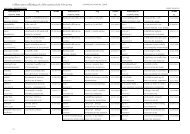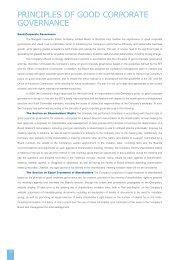Year 2007
Year 2007
Year 2007
Create successful ePaper yourself
Turn your PDF publications into a flip-book with our unique Google optimized e-Paper software.
Nevertheless, there are still many factors adversely affecting the economy, such as oil price volatility, which has an impact<br />
on a global scale, and consumer goods prices, including agricultural produce prices as more agricultural produce are used to<br />
generate alternative energy. Additionally, the sub-prime mortgage crisis in the US has contributed to the slowdown in the US<br />
economy, resulting in a weaker US dollar and a stronger Thai Baht, so slowing down Thai export growth since Thailand exports<br />
more to the US as compared to other countries. In contrast, this is also a good opportunity for the country to import machinery and<br />
other equipment to be used for production and the construction of mega-projects. Based on factors boosting the Thai economy,<br />
together with the problems the country is facing, the Bank of Thailand projects Thai economic growth of 4.5 to 6.0 percent in 2008.<br />
For the outlook of the non-life insurance industry, it will benefit from the economic recovery that is expected to be evident<br />
by the second half of 2008. This includes mega-project investments, enlargement of housing along electric train construction lines,<br />
total sales of new brands of eco-cars, and increasing purchasing power brought about by tax adjustment measures. The negative<br />
factor is that the Baht is likely to continue to appreciate, contributing to a decrease in premium written for aviation insurance.<br />
By and large, personal line business is still able to expand significantly and is a major target business of non-life insurance<br />
companies having a network and partners attracting personal customers. For high-risk insurance, like motor insurance, the<br />
premium rates are enhanced for some customer groups with a great loss, to be in accordance with rising business costs.<br />
Moreover, a reduction in compulsory motor insurance premium will cause small non-life insurance companies with a high<br />
proportion of compulsory motor insurance to promptly adapt themselves in order to secure sufficient income for augmenting risks<br />
and expenses. Meanwhile, for the underwriting of mega-projects, more cooperation can be expected among non-life insurance<br />
companies.<br />
It is also worth noting that so far the Office of Insurance Commission has drawn up a more stringent criterion for the insurance<br />
capital, which is based on risk (RBC), corresponding with the Insurance Act (Volume 2) of 2008 and becoming effective as of<br />
February 5, 2008. Though the criterion will not have an immediate impact since the law allows non-life insurance companies some<br />
time to adapt before it takes effect. However, since companies with a problem of capital will have to increase their capital to meet<br />
the requirement before the Act takes effect, we may see them resort to mergers in order to enhance their financial business and<br />
competitiveness in the future.<br />
13







